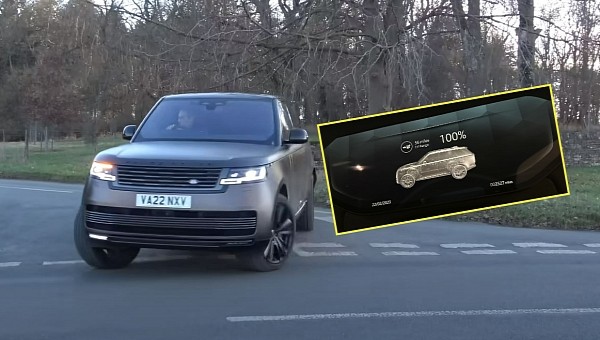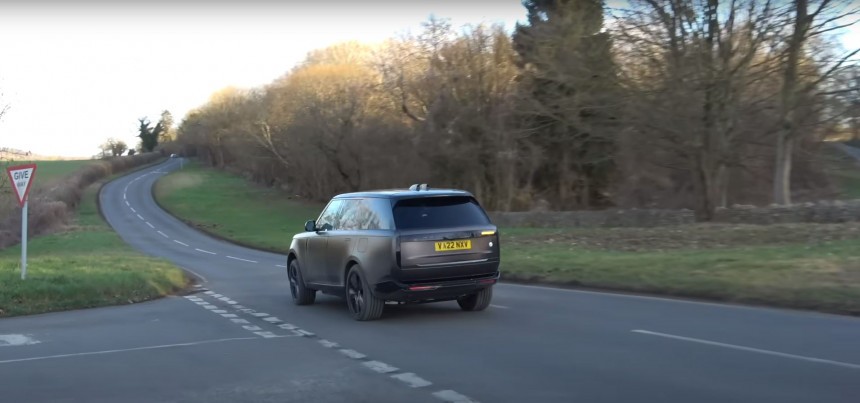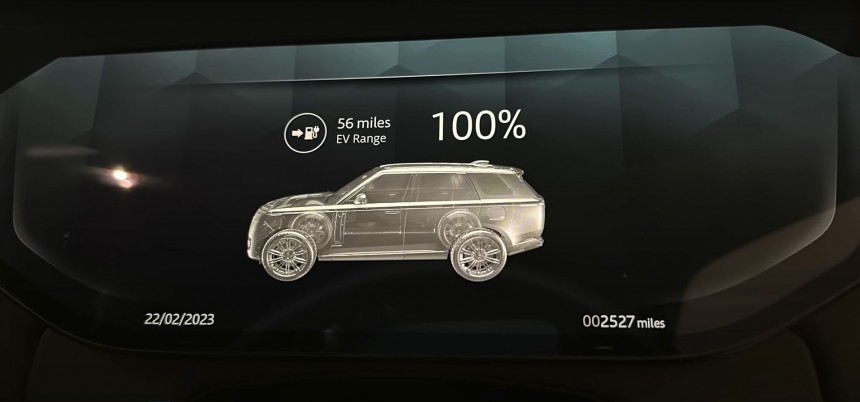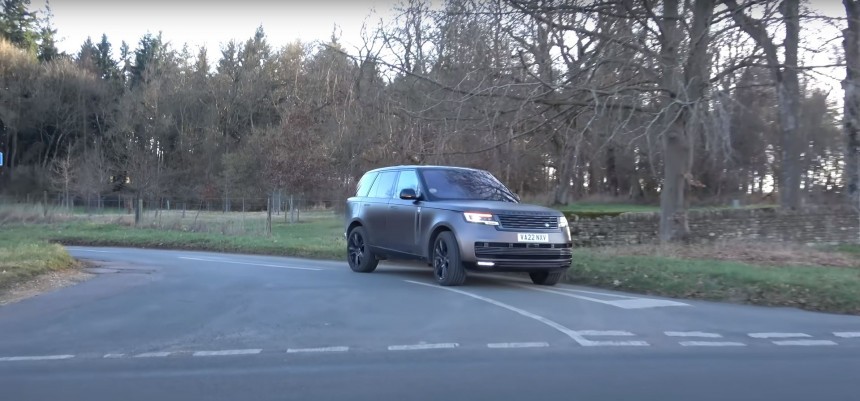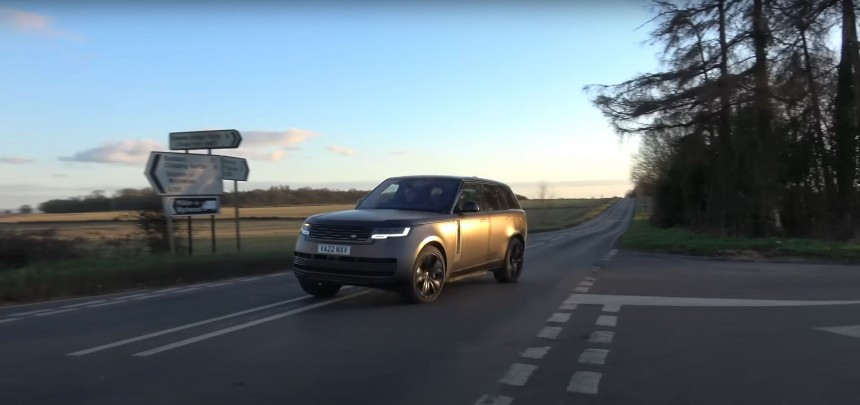Land Rover’s spanking-new top-of-the-range plug-in hybrid (PHEV) Range Rover can safely be called a work of art. The SUV is massive, refined, good-looking, packed with technology, and can double as a pure electric vehicle (EV) for up to 70 mi (113 km) thanks to a 31.8-kWh usable (38.2-kWh gross) battery. But is this three-ton behemoth worth buying? Let’s get an answer.
It’s just how it is – some love PHEVs, and others think they’re wasteful. I side with the former because there needs to be some sort of middle ground available for drivers before EVs become the norm everywhere. Besides, I believe people spending more money on an electrified SUV will be interested in using it right. This means they will charge it at home or work and strive to use it as an EV most of the time they are on the road. Otherwise, PHEVs can put more strain on the internal combustion engine, which can lead to higher fuel consumption. Thus, more unwanted emissions are… Well, emitted!
One PHEV that can serve its owners well is the 2023 Land Rover Range Rover P510e. It’s so good at having this dual identity that it even tricked the Worldwide Harmonised Light Vehicle Test Procedure (WLTP) to say that it returns a consumption of up to 353 mpg (0.7 l/100 km). Even in the event of a global catastrophe that leaves just the PHEV owner alone in the world with the easiest roads to drive on intact, a combined range of 6,636 mi (10,680 km) is just preposterous (imagine this last word spoken with a deep British accent). But that’s just how statistics and fuel consumption formulas work, which is enough to understand that we cannot trust these absurd figures.
A realistic combined consumption figure should be closer to something along the lines of 34 mpg (6.9 l/100 km). But there are too many factors involved in finding the figure that can apply to most Range Rover owners out there, so make sure to take even this approximation with a grain of salt.
Thankfully, real-world tests exist, and Land Rover did not shy away from letting people drive its posh Range Rovers. Evo car magazine founder Harry Metcalfe took one for a ride and did not abstain from sharing a couple of blunt conclusions. His opinion matters more than what others are saying because he owns an older Range Rover P400e. As an experienced Land Rover customer, the journalist can tell if the P510e is worth the money or not.
Starting in EV mode is what will happen on most occasions when the driver wants to go for a ride. This type of powertrain suits the Range Rover because it’s silent, delivers all the torque from the very first press of the accelerator pedal, and creates an effortless driving experience for everyone sitting in the cabin. Imagine it as a more luxurious Rivian R1S that can also stop at the pump for some good ol’ gas that’s needed to keep the six cylinders in action.
But the Range Rover P510e has only one 105-kW (141-hp/143-ps) AC motor which works with the three-liter engine to give the SUV a total power output of 503 hp (510 ps). This is what guarantees a naught to 62 mph (100 kph) time of 5.5 seconds and a top speed of 150 mph (241 kph).
However, this noiseless wafting brings us back to what we said in the beginning. Owners might start to like the EV experience more and more, which may in turn lead to more responsible PHEV usage. But Land Rover didn’t skimp on making the fossil fuel-hungry power unit any less refined, and that may be an issue for those who don’t pay a lot of attention to the battery’s charge level.
But, once again, everything depends on how the PHEV is being handled with every drive. The performance is there, but the potential to lessen the burden on the environment is not going anywhere either.
Secondly, Metcalfe says that the air suspension system may not be very well thought out because the posh SUV tends to skirmish when it meets sudden, sharp bumps on the road. He underlines that this feeling is odd and attributes it to the dampers that seem like they are not able to react promptly in such scenarios.
This is not a dealbreaker by any means, but it’s worth knowing that this luxurious behemoth may not handle roads with lots of ridges very well.
Thirdly, the real-world test also revealed that the engine tends to be more reactive. It comes into action even when it should not. Since the vehicle is pretty heavy, the engineers might have taken some preemptive decisions to not let owners feel like their expensive SUV is lacking any power.
The increased weight might also reflect on the brakes, as the British journalists noticed. There’s a considerable amount of stopping power, but you may have to change them more often if you consider yourself a spirited driver.
Fourthly, this test also revealed that the PHEV’s combined range isn’t very good. Unlike the WLTP rating, Metcalfe shared the figures and revealed a 61.2 mpg (3.8 l/100 km) fuel efficiency. That may appear impressive at first, but when you take into account the Honda e-sized battery pack found on the Range Rover P510e, this gas consumption figure should be even lower. This, once again, is tied to the SUV’s weight, which pushes efficiency down.
But it’s not all bad. The Range Rover P510e in SV form comes with all the bells and whistles of a proper Range Rover. This means you get all the possible interior space, the lavish exterior looks, some great connectivity options, an intuitive infotainment design, premium materials all throughout the vehicle, and an enhanced day-to-day usability thanks to options like the four-wheel steering. For a vehicle this size, it can come in handy when navigating busy streets.
Now, even though it is an expensive model, the British SUV remains cheaper than direct competitors like Bentley Bentayga or Porsche Cayenne. There's no need to involve Lamborghini or Aston Martin in this.
Sadly, U.S. customers only get the lesser Range Rover P440e model, which, at the time of writing, is also under a “limited availability” warning. Americans might just have to do with the refreshed X5 xDrive50e if they want to get a similar PHEV, but with a little more aggressiveness to it.
Finally, the one thing that Metcalfe is not happy about is the way this SUV consumes electricity – it’s just not as efficient as the previous-generation P400e, which has almost double the per-kWh mileage. It irks him that Land Rover did not think more about this aspect, a feeling with which I agree because PHEVs must be efficient if they are to serve as the halfway point to total electrification.
The British journalist even goes as far as to say that the diesel-powered version might make more sense. It’s around £3,500 ($4,375) cheaper and not as heavy as the PHEV, but we’ll let you decide if he’s right or not.
One PHEV that can serve its owners well is the 2023 Land Rover Range Rover P510e. It’s so good at having this dual identity that it even tricked the Worldwide Harmonised Light Vehicle Test Procedure (WLTP) to say that it returns a consumption of up to 353 mpg (0.7 l/100 km). Even in the event of a global catastrophe that leaves just the PHEV owner alone in the world with the easiest roads to drive on intact, a combined range of 6,636 mi (10,680 km) is just preposterous (imagine this last word spoken with a deep British accent). But that’s just how statistics and fuel consumption formulas work, which is enough to understand that we cannot trust these absurd figures.
A realistic combined consumption figure should be closer to something along the lines of 34 mpg (6.9 l/100 km). But there are too many factors involved in finding the figure that can apply to most Range Rover owners out there, so make sure to take even this approximation with a grain of salt.
Keeping it real
First thing first, we find out that 56 mi (90 km) is a realistic pure electric range on a chilly morning. As you may know, outside temperature can impact the battery’s full capacity. Since chemical and physical reactions happen slowly, the EV must spend energy to make heat so it can function normally, thus reducing the range.Starting in EV mode is what will happen on most occasions when the driver wants to go for a ride. This type of powertrain suits the Range Rover because it’s silent, delivers all the torque from the very first press of the accelerator pedal, and creates an effortless driving experience for everyone sitting in the cabin. Imagine it as a more luxurious Rivian R1S that can also stop at the pump for some good ol’ gas that’s needed to keep the six cylinders in action.
But the Range Rover P510e has only one 105-kW (141-hp/143-ps) AC motor which works with the three-liter engine to give the SUV a total power output of 503 hp (510 ps). This is what guarantees a naught to 62 mph (100 kph) time of 5.5 seconds and a top speed of 150 mph (241 kph).
It's up to you – the driver!
The electric motor delivering all its might at once and the battery helping the vehicle have a lower center of gravity are no good things for eco-driving either. The person sitting behind the steering wheel may get used to this, and their right foot could tend to get heavier and heavier on the accelerator pedal. This will undoubtedly activate the gas-powered engine more often, leading again to more fuel consumption and emissions.But, once again, everything depends on how the PHEV is being handled with every drive. The performance is there, but the potential to lessen the burden on the environment is not going anywhere either.
Secondly, Metcalfe says that the air suspension system may not be very well thought out because the posh SUV tends to skirmish when it meets sudden, sharp bumps on the road. He underlines that this feeling is odd and attributes it to the dampers that seem like they are not able to react promptly in such scenarios.
This is not a dealbreaker by any means, but it’s worth knowing that this luxurious behemoth may not handle roads with lots of ridges very well.
The increased weight might also reflect on the brakes, as the British journalists noticed. There’s a considerable amount of stopping power, but you may have to change them more often if you consider yourself a spirited driver.
Fourthly, this test also revealed that the PHEV’s combined range isn’t very good. Unlike the WLTP rating, Metcalfe shared the figures and revealed a 61.2 mpg (3.8 l/100 km) fuel efficiency. That may appear impressive at first, but when you take into account the Honda e-sized battery pack found on the Range Rover P510e, this gas consumption figure should be even lower. This, once again, is tied to the SUV’s weight, which pushes efficiency down.
Don't focus on the negatives
Fifthly, the SUV’s stability systems will cut power when you want to push the Range Rover in and out of a corner. Granted, it’s not made for that. But current and prospective owners should be aware of this.Now, even though it is an expensive model, the British SUV remains cheaper than direct competitors like Bentley Bentayga or Porsche Cayenne. There's no need to involve Lamborghini or Aston Martin in this.
Sadly, U.S. customers only get the lesser Range Rover P440e model, which, at the time of writing, is also under a “limited availability” warning. Americans might just have to do with the refreshed X5 xDrive50e if they want to get a similar PHEV, but with a little more aggressiveness to it.
Finally, the one thing that Metcalfe is not happy about is the way this SUV consumes electricity – it’s just not as efficient as the previous-generation P400e, which has almost double the per-kWh mileage. It irks him that Land Rover did not think more about this aspect, a feeling with which I agree because PHEVs must be efficient if they are to serve as the halfway point to total electrification.
The British journalist even goes as far as to say that the diesel-powered version might make more sense. It’s around £3,500 ($4,375) cheaper and not as heavy as the PHEV, but we’ll let you decide if he’s right or not.
